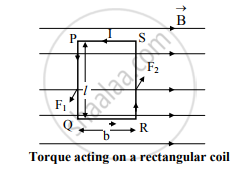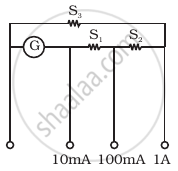Advertisements
Advertisements
प्रश्न
Show that the current flowing through a moving coil galvanometer is directly proportional to the angle of deflection of coil.
उत्तर
a. Suppose that rectangular coil PQRS is kept in uniform magnetic field of induction ‘B’. Let ‘n’ be the number of turns of the coil with ‘l’ as its length and ‘b’ as its breadth. The current ‘I’ is passed through it in anticlockwise direction.

b. The forces on QR and SP are equal to zero because they are parallel to B→
c. Force on PQ,
F1 = nIBl (directed normally outwards)
Force on RS,
F2 = nIBl (directed normally inwards)
d. Two forces F1 and F2 are equal in magnitude but opposite in direction and act at different points. Hence these forces constitute a torque (τ) and rotate the coil.
e. Magnitude of torque is given by,
τ = Magnitude of one of the forces × perpendicular distance between these parallel forces
∴ τ = (nBIl) (b) = nBI (lb)
∴ τ = nBIA
where, A = lb = area of rectangular coil PQRS
f. This torque deflects the coil hence it is called deflecting torque. It is given by,
τd = nBIA ….(i)
This torque causes the pointer attached to the coil to deflect and move on a graduated scale.
g. As the coil is deflected, the phosphor bronze wire is twisted. This twist in phosphor bronze wire provides restoring or controlling torque.

h. This restoring torque is directly proportional to the deflection of the coil.
i.e. τr ∝ θ
∴ τr = Cθ ….(ii)
where, the constant of proportionality C is called twist constant or restoring torque per unit twist.
i. For equilibrium of the coil, τd = τr
∴ nBIA = Cθ
∴ I = (C/nAB)θ .…(iii)
Equation (iii) represents the current flowing through M.C.G
j. For a given M.C.G., n, B, A are constant and for given suspension fibre
C = constant.
∴ C/nAB= k = constant
∴ I = kθ
∴ I ∝ θ
Hence, current flowing through galvanometer is proportional to deflection produced in it.
APPEARS IN
संबंधित प्रश्न
Write the underlying principle of a moving coil galvanometer.
Why does a galvanometer show a momentary deflection at the time of charging or discharging a capacitor? Write the necessary expression to explain this observation.
Obtain the expression for current sensitivity of moving coil galvanometer.
A circular coil of 250 turns and diameter 18 cm carries a current of 12A. What is the magnitude of magnetic moment associated with the coil?
A galvanometer of resistance G is converted into a voltmeter to measure upto V volts by connecting a resistance R1 in series with the coil. If a resistance R2 is connected in series with it, then it can measures upto V/2 volts. Find the resistance, in terms of R1 and R2, required to be connected to convert it into a voltmeter that can read upto 2 V. Also find the resistance G of the galvanometer in terms of R1 and R2
Draw a labelled diagram of a moving coil galvanometer. Describe briefly its principle and working.
Why is it necessary to introduce a cylindrical soft iron core inside the coil of a galvanometer?
Two moving coil meters, M1 and M2 have the following particulars:
R1 = 10 Ω, N1 = 30,
A1 = 3.6 × 10–3 m2, B1 = 0.25 T
R2 = 14 Ω, N2 = 42,
A2 = 1.8 × 10–3 m2, B2 = 0.50 T
(The spring constants are identical for the two meters).
Determine the ratio of
- current sensitivity and
- voltage sensitivity of M2 and M1.
A rectangular coil of a moving coil galvanometer contains 100 turns, each having area
15 cm2. It is suspended in the radial magnetic field 0.03 T. The twist constant of suspension
fibre is 15 x 10-10 N-m/degree. Calculate the sensitivity of the moving coil galvanometer.
A galvanometer has a resistance of 16Ω. It shows full scale deflection, when a current of 20 mA is passed through it. The only shunt resistance available is 0.06 which is not appropriate to convert a galvanometer into an ammeter. How much resistance should be connected in series with the coil of galvanometer, so that the range of ammeter is 8 A?
Why is it necessary to introduce a radial magnetic field inside the coil of a galvanometer?
How will you convert a moving coil galvanometer into a voltmeter?
With the help of a neat and labelled diagram, explain the principle and working of a moving coil galvanometer ?
Write current sensitivity of a galvanomete S.I. unit.
Explain, giving reasons, the basic difference in converting a galvanometer into (i) a voltmeter and (ii) an ammeter?
Outline the necessary steps to convert a galvanometer of resistance RG into an ammeter of a given range ?
State the underlying principle of working of a moving coil galvanometer. Write two reasons why a galvanometer can not be used as such to measure current in a given circuit. Name any two factors on which the current sensitivity of a galvanometer depends.
What are the advantages of using soft iron as a core, instead of steel, in the coils of galvanometers?
Why are the pole pieces of a horseshoe magnet in a moving coil galvanometer made cylinder in shape?
Explain the significance of a radial magnetic field when a current-carrying coil is kept in it.
A galvanometer coil has a resistance of 12 Ω and the metre shows full scale deflection for a current of 3 mA. How will you convert the metre into a voltmeter of range 0 to 18 V?
The AC voltage across a resistance can be measured using a ______.
The deflection in a moving coil galvanometer is ______.
The current sensitivity of a galvanometer is defined as ______.
The conversion of a moving coil galvanometer into a voltmeter is done by ______.
The coil of a moving coil galvanometer is wound over a metal frame in order to ______.
The current sensitivity of a galvanometer increase by 20%. If its resistance also increases by 25%, the voltage sensitivity will ______.
A galvanometer of resistance 100 Ω gives a full-scale deflection for a current of 10−5 A. To convert it into an ammeter capable of measuring up to 1 A we should connect a resistance of ______.
A multirange current meter can be constructed by using a galvanometer circuit as shown in figure. We want a current meter that can measure 10 mA, 100 mA and 1A using a galvanometer of resistance 10 Ω and that prduces maximum deflection for current of 1mA. Find S1, S2 and S3 that have to be used

When a galvanometer is shunted with a 4 Ω resistance, the deflection is reduced to one-fifth. If the galvanometer is further shunted with a 2 Ω wire. The further reduction (find the ratio of decrease in current to the previous current) in the deflection will be (the main current remains the same)
A galvanometer coil bas 500 turns and each tum has an average area of 3 × 10-4 m2. If a torque of 1.5 Nm is required to keep this coil parallel to a magnetic field when a current of 0.5 A is flowing through it, the strength of the field (in T) is ______.
A galvanometer having a resistance of 20 Ω and 30 Ω division on both sides has figure of merit 0.005 ampere/division. The resistance that should be connected in series such that it can be used as a voltmeter upto 15 volt, is ______.
A moving coil galvanometer has 150 equal divisions. Its current sensitivity is 10-divisions per milliampere and voltage sensitivity is 2 divisions per millivolt. In order that each division reads 1 volt, the resistance in ohms needed to be connected in series with the coil will be ______.
Explain in brief the basic construction of a moving-coil table galvanometer whit a neat labelled diagram.
A voltmeter has a range of 0 - 20 V and a resistance of 500 Q. Explain how can be used to measure voltages from 0 - 200 volt?
To convert a moving coil galvanometer into an ammeter we need to connect a ______.
Assertion: When an electric current is passed through a moving coil galvanometer, its coil gets deflected.
Reason: A circular coil produces a uniform magnetic field around itself when an electric current is passed through it.
